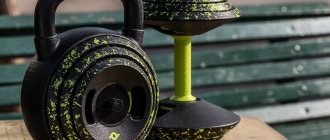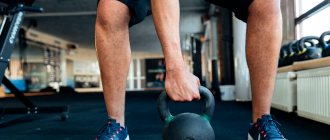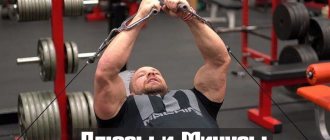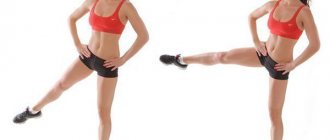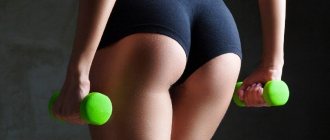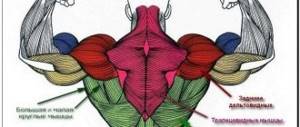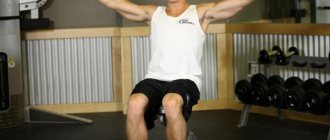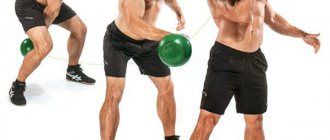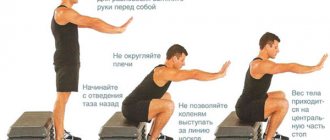Preparatory stage for exercises with a 16 kg kettlebell
This type of exercise is designed to effectively work out almost all muscle groups. They comprehensively develop endurance, functional strength, and agility. At the same time, weights will provide not only strength, but also cardio. This simple exercise will significantly strengthen your muscles, help you build a beautiful profile, and also burn excess fat.
Strengthening your hands
Without prior preparation, it is better not to try to perform complexes with kettlebells, especially heavy ones. Weak arms, hands, forearms and an insecure grip can lead to unexpected tendon injuries, muscle tears and ligament tears. In everyday life, such simple activities as chopping wood, hand washing, working with a two-handed saw, working with a shovel, rake, pitchfork and crowbar are good for strengthening your hands. Additionally, other sports target the appropriate muscles.
- Rowing.
- Struggle.
- Fencing.
- Gymnastics.
- Biathlon.
- Acrobatics.
- Workout.
- Rock climbing and mountaineering.
- Arm wrestling.
If you have done something similar before, then most likely no preparation will be required. But if not, you should first do push-ups, pull-ups, and deadlifts to strengthen the necessary muscles.
General Tips
- There are two types of weights: solid and prefabricated. The first already have a certain weight ahead of time, and in the second case you can independently adjust it by removing or adding parts of the projectile.
- To avoid injury, you need to start with light weights. Choose a 4, 6 or 8 kg kettlebell. Practice with them. Once you understand the principle and study the technique, you can move on to more serious weights.
- Keep in mind the unspoken rule: the more muscles the exercise you choose covers, the heavier the equipment you can use to perform it.
- Always start your workout with a good warm-up stretching exercise.
Any set of exercises with a kettlebell is much heavier and more intense than any exercise with a barbell or dumbbells. Therefore, you need to warm up before training more carefully, thoughtfully and attentively.
Haven't acquired a shell yet? It's time!
How to choose the right kettlebell: 16, 24 and 32 kg
Traditional projectile weights include 4, 16, 24 and 32 kg. However, almost all denominations of scales are available on the market. The price of the projectile depends on the mass.
Kettlebells are made from different materials:
- Plastic. Plastic projectiles are suitable for home training: there is no loud noise during exercise, and contact with the floor and furniture does not leave marks. The disadvantage is the short service life compared to metal ones. When purchasing a product made from high-quality plastic, there are no problems with service life.
- Cast iron. Cast iron weights are suitable for those who are interested in quality and large mass with small dimensions. The shells are protected from rust and can serve for a long time. However, if you use them carelessly, mechanical damage is possible.
- Become. Chrome-plated steel projectiles are reliable and have an attractive appearance. Some designs allow you to increase the mass by adding additional weight. However, the cost is significantly higher than analogues.
- Neoprene. Neoprene is a synthetic material that is chloroprene rubber or foam rubber. Neoprene shells are rare and are practical and reliable. Suitable for beginners due to low trauma. The rubber coating protects against mechanical damage.
Deciding on the choice of sports equipment depends on your experience in training. Beginning athletes should choose plastic or neoprene equipment. For experienced players, you can purchase metal shells.
The choice of mass depends on the person’s physical fitness. For beginners, it is not advisable to purchase high-mass equipment due to the risk of muscle fiber rupture.
Therefore, the best choice is to buy a weight of 16 kg or lower.
What weight should I start training at?
Here it is necessary to understand that, unfortunately, there is no specific formula.
Each person is individual and their exercise tolerance, physical capabilities, strength parameters, and health status are individual. Therefore, first of all, you need to undergo examination in the hospital, sadly, but you need to start your exercises with light weight. And only then move on to the next “level”, when the heart and other organs adapt to new conditions.
In other words, if a person decides to train with weights, he needs to be patient and not chase weight. You can move on to heavier weights if you manage to perform all the exercises that will be described below.
Shoes for training
Most athletes, bodybuilders in the gym, wear shoes that are not at all suitable for weight training. You need good shoes that are comfortable and safe. The ankle must be clearly fixed to avoid various sprains when performing heavy squats, leg presses, etc.
In addition, the non-slip surface of the sole and high sides of the shoes will also help you avoid all kinds of ankle injuries. Currently, the choice of inexpensive, up to $100, specialized shoes for bodybuilding is enormous.
Manufacturers are striving to more and more protect the athlete from injury; you just need to enter a query into the search engine “shoes for bodybuilding”, and you can easily find the pair of shoes you need for working out in the gym.
Which kettlebells to choose for men
Again, excluding genetically gifted people, the recommendation for men is a 16-kg weight. But unlike the fair sex, most men will look at a 16-kg weight with skepticism and many will say, “This is nothing at all! I do ***kg x **sets on the bench press!”
But the problem here is not that you can lift heavy weights, the problem is that training with a kettlebell involves many muscles that were isolated from the load when training with a barbell. Most likely, from the very first workout you will feel muscles that you have never felt before.
Due to the high intensity of training with kettlebells, many small muscles around the main groups (back, abdominals, legs, etc.) will simply “burn” during the first session. If you think 16kg kettlebells are too light, think again!
Men who have never trained with weights before are especially susceptible to failure to perform the correct technique, watch the technique, try to perform the exercises correctly and believe me - 16 kg of weights will be enough to start training.
Rules for performing exercises to reduce belly fat
Warm up before you start. Joint gymnastics, jumping and running in place are suitable.
Each subsequent approach should begin after a pause of 15-20 seconds.
If there is no other physical activity, then exercises for the abdominal muscles with weights should be performed up to 3-5 times a week.
How to remove fat deposits using home exercises and achieve effectiveness? Follow these rules:
- Gradual increase in loads. This is the main factor in all training. Beginners are prohibited from immediately starting gymnastics with a weight of 16 kg. It is important to gradually progress in weights, starting small. The body will gradually adapt, and you will become stronger and more prominent. This is the only way to pump up your stomach and accelerate muscle growth.
- Watch your diet. You won't be able to lose body fat and build a powerful body if you don't consume protein. You can't starve, but you can't overeat either. Proper, high-quality nutrition together with weights will help you achieve your goal in a short time. Forget about French fries, hamburgers, love vegetables, fruits, chicken breast and other dietary, but very tasty foods.
- Complete rest. Athletes know that good sleep is invaluable for effective training. You can do the 16-kilogram belly exercise every day, but you won’t achieve results if you don’t rest. When lifting weights, muscle cells are destroyed and the body experiences enormous stress. You can recover and become stronger only with the help of subsequent rest.
If you decide to develop your own complex on how to pump up your abs with kettlebells and remove extra centimeters, then be sure to include tasks for working out all sections of the middle part. Don't forget about the exercises to work on the oblique muscles. They will help make your body beautiful and strong.
Turkish get up with kettlebell
Don’t forget about the difficulties, one of which is the Turkish get-up exercise with a kettlebell. It strengthens joints, makes ligaments elastic and, as usual, pumps up the muscles of the whole body. In addition, the Turkish get-up is very good for improving balance and coordination.
How to do:
Lie on the floor, bend your supporting leg (for example, your left) at the knee and get ready to grab the weight with your left hand. Pull the projectile towards you, and then straighten your left arm up with it.
Without lowering the weight, begin to rise up, leaning on your free arm and legs. Ultimately, you should be standing at full height with your arm extended above your head along with the kettlebell. Now try to return to the starting position (that is, lie down) with your arm still straightened.
Here the number of repetitions depends on your functionality. Perhaps five to seven repetitions will be enough to start with.
Exercises to develop coordination of movements[edit | edit code]
Report
- Raise the weight to an outstretched arm above your head. Without lowering it, squat down and take the second weight standing on the floor with your other hand. Rising from a squat, bring the weight to your shoulder, then press it overhead. After holding for a second, lower both weights onto your shoulders and then place them on the floor.
- The exercise is usually performed in one repetition, but with the maximum possible weight.
Upside down kettlebell push-up
- Take a standing position, the torso is slightly tilted forward, the weight is in the lowered hand.
- With a slight jerk, bring the weight to your shoulder and hold it with the bottom up, smoothly lift it above your head, and after 1 second lower it back to your shoulder. After this, you can either do a few more presses without turning the weights, or return to the starting position and perform a new repetition from the beginning.
Juggling
- This exercise makes sense to perform at the end of any kettlebell workout.
- Lean forward and pick up the weight. The free hand rests on the hip. Swing the weight between your legs and swing it forward with your straight arm. When the weight is at head level, sharply release it and accelerate it downward and away from you. After the kettlebell has completed a full rotation, grab it by the handle and let it move between your legs by inertia for a new repetition. Be sure to perform the exercise with your second hand. Over time, you can learn to juggle with both hands at once.
The combination of exercises depends on the specific goals and preferences of the athlete.
If you have enough endurance, you can combine all the exercises into one session and reduce the rest time between sets to 40-50 seconds. It is best with this scheme to alternate the load on the upper and lower body.
The sequence in this case could be like this:
- 1st exercise - 4 approaches;
- 6th exercise - 3 approaches;
- 2nd exercise - 3 approaches;
- 5th exercise - 3 approaches;
- 3rd exercise - 3 approaches;
- 4th exercise - 3 approaches.
From such training, the cardiovascular system will experience enormous overload, and the lungs will have to adapt to new conditions. As a result, all this will lead to an increase in overall endurance, and consequently, to an increase in body tone, improved hormonal status, etc.
After several such workouts, the fat layer will disappear completely, and the muscles will look pumped up.
With such a training system, it is necessary to allocate at least 3-4 days in a row for rest.
It is possible to divide workouts by muscle groups. For example, on the 1st day the muscles of the upper body are loaded, and after 1-2 days of rest - the lower ones, then again 1 day is set aside for rest.
First training
:
- 1st exercise - 3 approaches;
- 2nd exercise - 3 approaches;
- 3rd exercise - 3 approaches.
Second training
:
- 4th exercise - 3 approaches;
- 5th exercise - 3 approaches;
- 6th exercise - 3 approaches.
Thus, the entire program can be completed in 4-6 days: depending on the individual recovery speed of the bodybuilder.
The Best Kettlebell Exercises for Home Workouts
For men
Deadlift with 16 kg kettlebell
- Feet slightly wider than shoulder width, toes turned outward, back straight.
- Lean slightly forward, bend your knees, and grab the weight with both hands.
- Without leaning forward or backward, rise up by straightening your knees, keeping your heels firmly planted.
- Return to the starting position.
Swing kettlebells in different directions
- The starting stance is standard, do not forget about a straight back.
- Grab the bow with both hands.
- Swing from a kettlebell position between your legs, just like a regular swing. You just need to direct the projectile to the side.
Mill
- Starting position: feet shoulder-width apart, toes turned outward, projectile in a vertically extended hand.
- While looking at the weight, lower your free hand, bend over and touch your fingers to the floor.
- Return to the starting position.
- Lower the projectile to the floor, repeat with the other hand.
For women
One-legged bends (Romanian deadlift)
- Hold the weight with one hand.
- Slowly lean forward, holding the apparatus hanging, while simultaneously moving the opposite leg as far back as possible.
- Keeping your back straight, return to the starting position. For balance, it is permissible to move your free hand to the side.
Lunges with transfer
- Take the inventory in one hand.
- Lunge according to the standard pattern.
- At the bottom point, pass the weight from one hand to the other.
- Rise to the starting position.
Circular transmission
- Grab a kettlebell with one hand and stand in a standard stance with your feet shoulder-width apart and toes pointing out.
- Rotate the weights around your body.
- From behind, pass the projectile from one hand to the other.
- In front, change hands again, continuing the movement.
Are kettlebells effective for weight loss and muscle growth?
After specialists conducted a number of experiments on athletes, it was revealed that kettlebell training is energy-consuming. The average energy spent on training is about 1200 kilocalories per hour of exercise. The reason is a large number of simultaneously loaded muscles and a high pace of exercise.
Thanks to this feature, training with kettlebells actively helps you lose weight. If you want to reduce the amount of fat in the body and significantly strengthen muscle mass, it is advisable to use the apparatus 2-4 times every 7 days for 20-45 minutes. Due to the stress on the heart and muscles, training does not involve the use of other types of exercises.
However, the growth of muscle mass when using a projectile is significantly inferior to specialized devices. Dumbbells and barbells have a great effect. Therefore, it is worth using weights when gaining muscle at intervals of several days.
Exercises with kettlebells for all muscle groups
For 12 years now, I have been asking people of all ages and fitness levels: “What’s so special about kettlebells?” These steel balls not only allow you to perform high-quality sports, but also perform a sufficient number of exercises. I mean one weight that doesn't take up much space.
httpv://www.youtube.com/watch?v=embed/9JF9tRW6P3M
For now, let's talk about just one weight. Perhaps someone has only one available or someone is just a beginner athlete. Well, or there are several weights, but this person prefers to put them aside and work with one instead of running from one machine to another in the gym. Perhaps someone already has experience with kettlebells and simply prefers to work with one.
Training program from Pavel Tsatsouline
Kettlebell training is something. The number of movements with weights significantly exceeds other equipment: dumbbells, exercise machines, free weights.
Their design involves a number of interesting exercises. The kettlebell combines cardio and strength training into a powerful combination. It's a rhythmic element that does wonders for your body balance and really raises your heart rate above anything else. Plus, just 10-15 minutes with weights and you'll tear yourself apart.
Most of Pavel's videos are currently only available in English, however they give an excellent overview of the movement techniques.
This complex is performed with two weights. According to the author, the program will force you to discover your body in a new way, and build muscle mass in the process.
Ready-made kettlebell lesson plan
We offer you a ready-made workout plan with kettlebells: for the upper body, for the lower body, for the abs and for the whole body. If you want to work on muscle mass, then perform no more than 15 repetitions with the maximum possible weight. If you want to work on fat burning and definition, then perform exercises for 15-20 repetitions with a medium weight.
If you set aside one day for kettlebell training and plan to train the whole body, you can perform all the suggested exercises in one approach. If you train the upper and lower body separately, you can perform each exercise in several approaches or repeat the exercises sequentially in several circles.
Kettlebell exercises for the upper body:
- Overhead kettlebell rotation: 15-20 reps
- Kettlebell Press: 10-15 reps (each arm)
- Kettlebell Rows for Back: 10-15 reps (each arm)
- Casting: 10-15 reps (each hand)
- Kettlebell Pull to Chest: 15-20 reps
- Push-ups: 10-20 reps (can be done from the knees)
- Kettlebell pullover for triceps: 10-20 reps
Abdominal exercises with kettlebells:
- Mill: 10-15 reps
- Russian twist with kettlebell for abs: 10-15 reps (each side)
- Horizontal running: 20-25 reps (each side)
- Rotation of the kettlebell around the body: 10-15 repetitions (each direction)
- Abdominal sit-ups: 10-15 reps
- Side plank: 30 seconds (each side)
Kettlebell exercises for the lower body:
- Kettlebell Chest Squat: 10-20 reps
- Squat with legs raised: 15-20 reps
- Single leg deadlift: 10-20 reps
- Back lunges with weights thrown: 10-15 reps (each leg)
- Jump squats: 15-20 reps
- Combo squat: 10-15 reps
Full body kettlebell exercises:
- Kettlebell Squat: 10-15 reps (each arm)
- One-arm kettlebell push: 10-15 reps (each arm)
- Kettlebell deadlift: 10-20 reps
- Swing: 10-20 reps
- Lateral lunge with kettlebell press: 10-15 reps (each leg)
- Squats + bicep curls: 10-15 reps
- Turkish get up: 5-7 reps
Kettlebell Training Tips
Be sure to warm up before your workout and cool down after your kettlebell workout. When preparing to perform exercises with a kettlebell, the muscles and ligaments should be well warmed up. Choose the weight of the kettlebell based on your strength capabilities: the last repetition in the approach should be performed with maximum effort. You can start training with a 4 kg (for girls) and 8 kg (for men) weights, gradually increasing the weight of the apparatus. If you already have sufficient training experience, then on average the recommended kettlebell weight for men: 16-24 kg, for women: 8-16 kg. During exercises with a kettlebell, keep your back straight and do not slouch. During squats, move your pelvis back to protect your lower back from injury. Try to keep your hands in a neutral position, without any bending. You can use special wrist braces to help you support your joints. Perform each exercise slowly while maintaining complete control. Do not swing the weight and perform exercises quickly and at speed.
Proper exercise form is the most important thing in kettlebell training. If you are working on muscle growth, you should not do kettlebell exercises more than once a week.
Kettlebell training allows you to develop endurance and explosive muscle strength, which will help move the plateau and provoke muscle growth. But for anabolic training it is better to use dumbbells and a barbell. If you have two kettlebells available, you can perform exercises using both kettlebells at the same time. Note that in this case the kettlebells should be the same size to avoid imbalance in muscle development. Examples of exercises:
Bodymaster.ru recommends Fitness Trainers:
In the fifth week we increase the MAXIMUM by +1 (total 6 and 7)
In the sixth week we increase the MAXIMUM by +2 from the base (total 7 and 8).
| Week 5 | Week 6 |
| Monday – A/press (X+1) Wednesday – B / squats (Y+1) Friday – A/press (X+1) | Monday – B / squats (Y+2) Wednesday – A/press (X+2) Friday – B / squats (Y+2) |
That's all. In six weeks, you will see your own gains in meat, and you will also feel your body in a new way. Unload yourself with a week of fun and easy training and you are ready for strength training that uses the “pyramid” (1, 2, 3, 2, 1).
These six-week workouts can be scheduled several times a year. Remember that you need to eat a good and balanced diet in order to gain quality mass.
Rest
You can rest between approaches as much as you see fit. A good guideline is restoring breathing. Rest one day between workouts.
What muscles work during kettlebell training?
Exercises with a projectile involve the muscles of the limbs, chest, abs and pelvis. Therefore, using kettlebells is suitable for overall body development. It is possible to use the apparatus for isotonic exercises, but the main goal is the development of all muscle groups.
When working with a projectile, the stabilizing muscles – adductors and abductors – are subject to load. Due to the shape of the projectile, the activation and use of abductors and adductors is required, while the motor skills of the groups are wider due to the varied number of movements. Traditional sports equipment - dumbbells and barbells - use the adductor and abductor muscles weaker during work.
Therefore, during kettlebell lifting the following are especially active:
- leg muscles (quadriceps and adductors);
- back of the body (longissimus, gluteal, pelvic, biceps femoris muscles);
- body (press and stabilizing);
- arm muscles (especially the forearm).
To increase the effectiveness of exercise, you need to learn how to distribute the level of load throughout the body. Lack of footwork significantly reduces the results of the training.
The best exercises with a kettlebell
Let’s consider the “Three Heroes” kettlebell complex from the classic Wod CrossFit. It consists of effective exercises with kettlebells, known since the times of Tsarist Russia.
Let's look at each movement separately:
Kettlebell swing with one/two hands (swings)
Otherwise, this exercise is called “Russian swings” or shifts. Remember, the main thing in performing this movement is inertia, not the force of the shoulder muscles. As you lower the kettlebell, give in to the weight and allow it to pull you down, and then, springing your hips, throw it back up to shoulder level. One repetition is equal to one swing.
Place the weight between your legs. Moving your pelvis back, grab the kettlebell by the handle. The gaze is directed forward. Press the weight towards your shoulder and at the same time turn your wrist with your palm facing forward. Lower the weight to the starting position.
One-arm kettlebell snatch
The kettlebell snatch is a basic exercise in kettlebell lifting, which is aimed at developing endurance and working out the entire shoulder girdle. With the correct technique, your shoulders will become more powerful and strong.
One-arm kettlebell snatch
When performing exercises with a kettlebell for beginners, there are small concessions, for example, a beginner is allowed to hold the kettlebell with both hands, while in the professional version, only the hands change at the top point of lifting the kettlebell.
And additionally, you can suggest for working the chest and latissimus muscles:
Plyometric push-ups
To perform this exercise, start in a prone position with one hand on the floor and the other on a kettlebell. Perform a push-up and jerk yourself off the floor. Springing with both hands, smoothly touch the floor and repeat all over again.
Plyometric push-ups with kettlebell
One arm bent over row
To perform this exercise, hold a kettlebell in your right hand and lean your body forward. If you have recently started training, do repetitions with only one kettlebell; in the professional version, the exercise is performed with two equipment at once.
Bent-over one-arm kettlebell row
Deep squats with a kettlebell
Grab a light weight by the handle with both hands. Hold it at chest level. Perform a deep squat. Your thighs should touch your shins. Keep your back straight. The gaze is directed forward. The knees are turned to the sides. Pause at the bottom and rise to the starting position.
Kettlebell Squats
For amateurs, we recommend considering the following best exercises from the Forge of Sports. Over 30 exercises with one kettlebell!
Basic exercises[edit | edit code]
- Kettlebell swings
are an exercise that develops explosive strength and strengthens the muscles of the hips, back and buttocks. - The kettlebell clean
is a preparatory exercise that is used in kettlebell lifting for warming up or while learning the technique of performing a clean and jerk. - The kettlebell snatch
is a classic kettlebell exercise. - The kettlebell jerk
is a competitive kettlebell lifting movement consisting of a series of intermediate movements. - Kettlebell presses
are an exercise for developing the muscles of the shoulder girdle, along with barbell or dumbbell presses.
Squeezing a weight over your head
Take a standing position with your feet shoulder-width apart or slightly wider. Kettlebell on the floor at your feet. - Bend over and firmly grasp the kettlebell by the handle with one hand. Straightening up, force the weight onto your shoulder (weight on the outside of the wrist). From this position, press (or push) the weight onto your straightened arm above your head. Hold the position for 1 second. Return the projectile to your shoulder, then lower it to the floor. Repeat the exercise without pause.
- Take a standing position, weights on your shoulders. When one hand lifts the weight, the other lowers it.
- Take a standing position, weights on your shoulders. Using the strength of your arms (slight inertia from the torso is possible), press the weights onto straight arms above your head. After a short pause, lower the weights onto your shoulders and immediately begin a new repetition.
- Kettlebell squats
are an excellent exercise for developing the muscles of the thighs and buttocks.
Deep squats
Take a standing position on a bench, weights in your lowered hands. Lower yourself into a deep squat with your torso slightly tilted forward and rise up without pausing. - This exercise, due to the specific placement of the weight, allows you to use the muscles of the buttocks and biceps of the thighs much more than any other type of squat.
- This exercise provides an excellent opportunity to load the muscles in a more balanced manner than when working with a barbell, therefore allowing for faster progress.
- Lunges, walking lunges
Take a standing position with two weights resting on your shoulders. In both types of exercises, the buttocks are included in the work. When walking, the overall load is distributed closer to the front of the thigh, and with regular lunges, it is distributed closer to the back.
Exercise options by muscle group[edit | edit code]
Leg exercises
- good morning exercise
- Kettlebell Squats
- Overhead Kettlebell Squats
- “Good morning” is a great exercise for a healthy back and toned buttocks.
- Weighted squats are great for building strength and mastering proper lifting technique.
- Overhead squats develop flexibility, strength and endurance in the back and legs.
Core Exercises
- good morning exercise on one leg
- "Turkish" rise
- Turkish squats with kettlebell
- Rowing
- Rowing with push-ups
- Weighted crunches
- Windmill exercise
- Good morning exercise on one leg with weights - triple the benefits of one exercise: balance, glutes and core.
- With strength, flexibility and balance, the Turkish get-up is the best all-around core strengthening exercise.
- Rowing - to increase endurance in the shoulders and lateral abdominal muscles.
- Push-up Rowing - Develops three-dimensional strength in the shoulders and core.
- Weighted crunch - hips, back, stomach - all in one exercise.
- Windmill - this exercise will give maximum load to the lateral abdominal muscles.
Hand exercises
- Army press
- Rotating around your head
- Clean up
- Overhead press
- Kettlebell Bench Press
- T-turn push-up
- Retraction of hands behind the head with weights
- Shoulder press
- Push press
- The military press is an exercise for strong, healthy shoulders that also stabilizes the core.
- Rotation around the head - a circular movement for flexibility of the shoulder joints and a toned core.
- Chest raises are preparation for lifting heavy objects overhead.
- The overhead press is an exercise worth a whole gym.
- The bench press is the best exercise for developing balanced and ready-to-load pectoral muscles.
- The T-turn push-up is the best exercise for developing balanced and ready-to-load pecs.
- Pulling your arms behind your head with weights is a great exercise that, along with the pectoral muscles, also strengthens the abdominal muscles.
- Shoulder Press – Develops grip strength and core stability while maintaining shoulder flexibility.
- The push press is a speed workout for good hand-foot coordination.
Multi-joint exercises
- Deadlift with kettlebell
- Kettlebell swing
- Farmer's Walk
- Rowing
- One arm swing
- Walking with lunges
- Lifting the kettlebell to the shoulder in the clean and jerk
- Kettlebell Snatch
- Rotating around your head in a squat
- Gladiator
- The deadlift is a basic exercise for lifting heavy weights with proper form for your back and for toning the backside.
- Max is very useful for those who spend a lot of time sitting.
- Farmer's walk - core stabilization, try something different.
- Rowing - Improves balance and bilateral strength.
- One-Arm Swing – Improves strength endurance and posture.
- Walking lunges are a super hip exercise that keeps your core flexible.
- Raising to the shoulder in the jerk - to increase strength in the shoulder girdle.
- Snatch - uses the muscles of the whole body.
- Rotating around your head in a squat improves stability, flexible shoulders and a strong back.
- Gladiator - For Experts: Strength and control of the hips, core and shoulders.
Exercises for experienced athletes
Now let's move on to considering the basic principles of conducting classes for more experienced weightlifters. An experienced athlete knows that kettlebells are an amazing piece of equipment that allows you to work all the muscles of the body. Therefore, an experienced athlete can decide for himself what to work on in a particular training session.
Kettlebells are unique in that they allow you to experiment with each new workout. So, the number of exercises is endless. The most difficult thing in this sport is circuit training, which includes working on all muscle groups.
httpv://www.youtube.com/watch?v=embed/uS1zFxtUbWU
Exercises: general characteristics
There are many different exercises that a person can do with this athletic equipment. Kettlebells are used not only in weightlifting, but also in boxing and other contact martial arts. However, even in such a modern and popular form of physical activity as CrossFit, kettlebells have found their application.
It is true that kettlebells are a unique athletic equipment that allows you to develop various parts of the body
Both beginners and professionals will be able to significantly improve their physical performance thanks to classes that can take place at home, which is important. That is, the person remains free and not tied to the gym
httpv://www.youtube.com/watch?v=embed/sbeaqMGJeSs
Biathlon - Clean and Jerk
Two-handed kettlebell push
- Rate by minute: 9, 10, 10, 3
- Body part: Shoulders Equipment: Kettlebells
Two-handed kettlebell push
- Tempo by minute: 11, 11, 11, 11, 12, 12, 6
- Body part: Shoulders Equipment: Kettlebells
Treadmill workout
- 4 km in the third zone
- Body part: Quadriceps Equipment: Exercise
Add to Calendar * Add to My Workouts * Print Workout
* — The service is in beta testing
Stretching - 15-20 minutes after the complex.
